check engine BMW 330CI COUPE 2004 E46 Owner's Manual
[x] Cancel search | Manufacturer: BMW, Model Year: 2004, Model line: 330CI COUPE, Model: BMW 330CI COUPE 2004 E46Pages: 174, PDF Size: 2.73 MB
Page 9 of 174

Contents
9
Passenger safety systems:
Airbags51
Transporting children safely54
Vehicle Memory, Key
Memory58
Driving:
Ignition lock59
Starting the engine59
Switching off the engine61
Parking brake61
Manual transmission62
Sequential manual gearbox
SMG*63
Automatic transmission with
Steptronic*67
Turn signal indicator/Headlamp
flasher70
Washer/wiper system/Rain
sensor*71
Cruise control*72
Everything under control:
Odometer74
Tachometer74
Energy control74
Fuel gauge75
Engine coolant temperature
gauge75
Service interval display76
Check Control76
Clock77
Computer78
Technology for safety and
driving convenience:
Park Distance Control (PDC)*80
Dynamic Stability Control
(DSC)81
Flat Tire Monitor*82
Brake force display84
Lamps:
Parking lamps/Low beams85
Adaptive headlights*86
Instrument lighting86
High beams/Standing lamps87
Front fog lamps87
Interior lamps88
Controlling the climate for
pleasant driving:
Air conditioning90
Automatic climate control*94
Roller sun blind*98
Interior conveniences:
Premium sound system*99
Glove compartment99
Storage compartments100
Microphone*101
Ashtray, front*102
Ashtray, rear*102
Clothes hooks103
Loading and transporting:
Through-loading system104
Ski bag*105
Cargo loading106
Roof-mounted luggage
rack*109
Controls and features
Page 17 of 174

17
1Fuel gauge75
2Indicator lamp for turn signals20
3Speedometer
4Indicator and warning lamps18
to20
5Tachometer and Energy Control74
6Engine coolant temperature
gauge75
7Indicator and warning lamps18
to20
8Control button for the clock77
9Selector lever and program display
for automatic transmission/sequen-
tial manual gearbox SMG, transmis-
sion indicator lamp19, 65, 69
10 Display for
>
Trip odometer/Odometer74
>
Clock77
>
Service interval76
>
Computer78
11 Check Control76
12 Trip odometer, reset to zero74
13 Indicator and warning lamps18
to20
Instrument cluster
OverviewControlsMaintenanceRepairsDataIndex
Page 18 of 174

18
Indicator and warning lamps
Technology that monitors itself
Indicator and warning lamps that are
identified by
●
are tested for proper
functioning whenever the ignition key is
turned. They each light up once for dif-
ferent periods of time.
If a fault should occur in one of these
systems, the corresponding lamp does
not go out after the engine is started, or
it lights up while the vehicle is moving.
You will see how to react to this below.
Red: stop immediately
Battery charge current
●
The battery is no longer being
charged. Indicates a defective
alternator drive belt or a problem with
the alternator's charge circuit. please
contact the nearest BMW center.
If the drive belt is defective, stop
and switch off the engine immedi-
ately to prevent overheating and seri-
ous engine damage. If the drive belt is
defective, increased steering effort is
also required.
<
Engine oil pressure
●
The engine oil pressure is too
low. Stop the vehicle immedi-
ately and switch off the engine. It is not
possible to continue driving. Please
contact the nearest BMW center.
Do not continue driving, as the
engine could sustain serious dam-
age from inadequate lubrication.
<
Brake warning lamp
●
If the lamp comes on when the
parking brake is not engaged:
check the brake fluid level. It is very
important that you follow the instruc-
tions on page 128 before driving on.
Have the system checked immediately.
Brake warning lamp for Cana-
dian models.
Flat Tire Monitor
●
In addition, an acoustic signal is
sounded: there is a flat tire.
Reduce speed and carefully come to a
stop. Avoid sudden braking and steer-
ing maneuvers.
For additional information, refer to
page 83.
Red and yellow: continue driving
cautiously
The brake warning lamp comes
on together with the yellow indi-
cator lamps for ABS
●
and
DSC:
The entire ABS, CBC and DSC
control system has failed. Con-
tinue driving cautiously and
defensively. Avoid hard brake
applications. Please have the system
checked by your BMW center as soon
as possible.
Additional information beginning on 81.
CBC, ABS and DSC and DBC
indicator and warning lamps for
Canadian models.
Red: an important reminder
Brake warning lamp
Comes on when the parking
brake is applied – an additional
acoustic signal sounds when starting
off.
For additional information, refer to
page 61.
Page 19 of 174
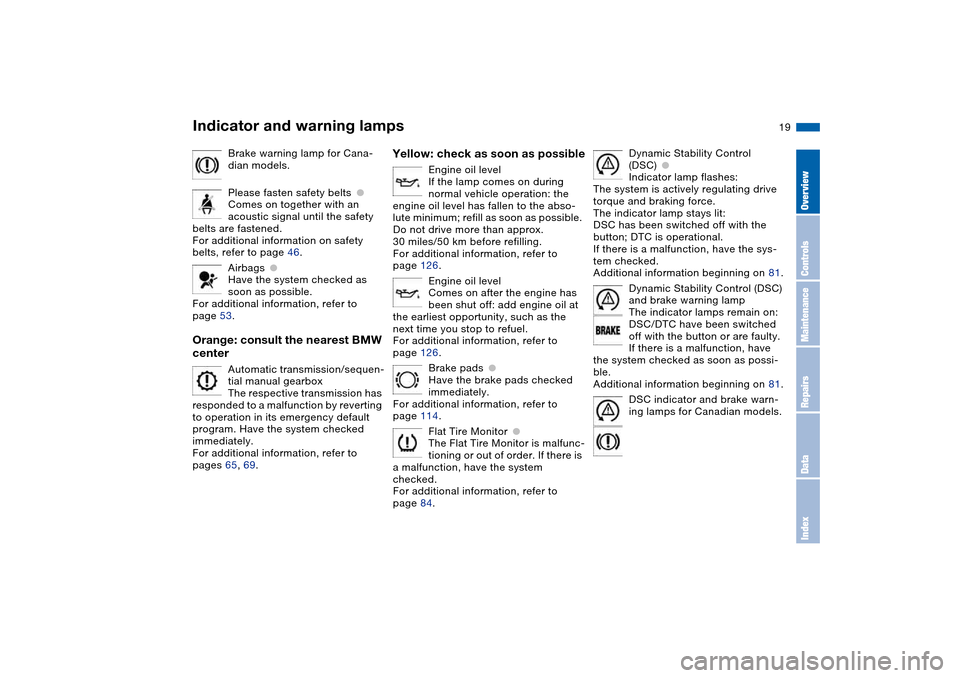
19
Brake warning lamp for Cana-
dian models.
Please fasten safety belts
●
Comes on together with an
acoustic signal until the safety
belts are fastened.
For additional information on safety
belts, refer to page 46.
Airbags
●
Have the system checked as
soon as possible.
For additional information, refer to
page 53.
Orange: consult the nearest BMW
center
Automatic transmission/sequen-
tial manual gearbox
The respective transmission has
responded to a malfunction by reverting
to operation in its emergency default
program. Have the system checked
immediately.
For additional information, refer to
pages 65, 69.
Yellow: check as soon as possible
Engine oil level
If the lamp comes on during
normal vehicle operation: the
engine oil level has fallen to the abso-
lute minimum; refill as soon as possible.
Do not drive more than approx.
30 miles/50 km before refilling.
For additional information, refer to
page 126.
Engine oil level
Comes on after the engine has
been shut off: add engine oil at
the earliest opportunity, such as the
next time you stop to refuel.
For additional information, refer to
page 126.
Brake pads
●
Have the brake pads checked
immediately.
For additional information, refer to
page 114.
Flat Tire Monitor
●
The Flat Tire Monitor is malfunc-
tioning or out of order. If there is
a malfunction, have the system
checked.
For additional information, refer to
page 84.
Dynamic Stability Control
(DSC)
●
Indicator lamp flashes:
The system is actively regulating drive
torque and braking force.
The indicator lamp stays lit:
DSC has been switched off with the
button; DTC is operational.
If there is a malfunction, have the sys-
tem checked.
Additional information beginning on 81.
Dynamic Stability Control (DSC)
and brake warning lamp
The indicator lamps remain on:
DSC/DTC have been switched
off with the button or are faulty.
If there is a malfunction, have
the system checked as soon as possi-
ble.
Additional information beginning on 81.
DSC indicator and brake warn-
ing lamps for Canadian models.
Indicator and warning lamps
OverviewControlsMaintenanceRepairsDataIndex
Page 20 of 174
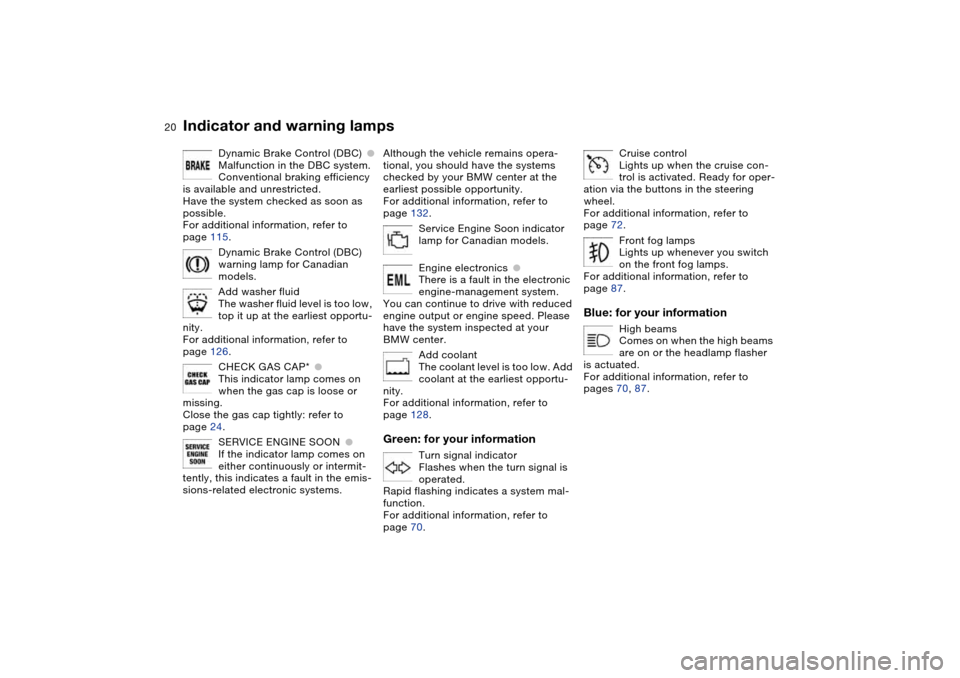
20
Dynamic Brake Control (DBC)
●
Malfunction in the DBC system.
Conventional braking efficiency
is available and unrestricted.
Have the system checked as soon as
possible.
For additional information, refer to
page 115.
Dynamic Brake Control (DBC)
warning lamp for Canadian
models.
Add washer fluid
The washer fluid level is too low,
top it up at the earliest opportu-
nity.
For additional information, refer to
page 126.
CHECK GAS CAP*
●
This indicator lamp comes on
when the gas cap is loose or
missing.
Close the gas cap tightly: refer to
page 24.
SERVICE ENGINE SOON
●
If the indicator lamp comes on
either continuously or intermit-
tently, this indicates a fault in the emis-
sions-related electronic systems.
Although the vehicle remains opera-
tional, you should have the systems
checked by your BMW center at the
earliest possible opportunity.
For additional information, refer to
page 132.
Service Engine Soon indicator
lamp for Canadian models.
Engine electronics
●
There is a fault in the electronic
engine-management system.
You can continue to drive with reduced
engine output or engine speed. Please
have the system inspected at your
BMW center.
Add coolant
The coolant level is too low. Add
coolant at the earliest opportu-
nity.
For additional information, refer to
page 128.
Green: for your information
Turn signal indicator
Flashes when the turn signal is
operated.
Rapid flashing indicates a system mal-
function.
For additional information, refer to
page 70.
Cruise control
Lights up when the cruise con-
trol is activated. Ready for oper-
ation via the buttons in the steering
wheel.
For additional information, refer to
page 72.
Front fog lamps
Lights up whenever you switch
on the front fog lamps.
For additional information, refer to
page 87.
Blue: for your information
High beams
Comes on when the high beams
are on or the headlamp flasher
is actuated.
For additional information, refer to
pages 70, 87.
Indicator and warning lamps
Page 24 of 174
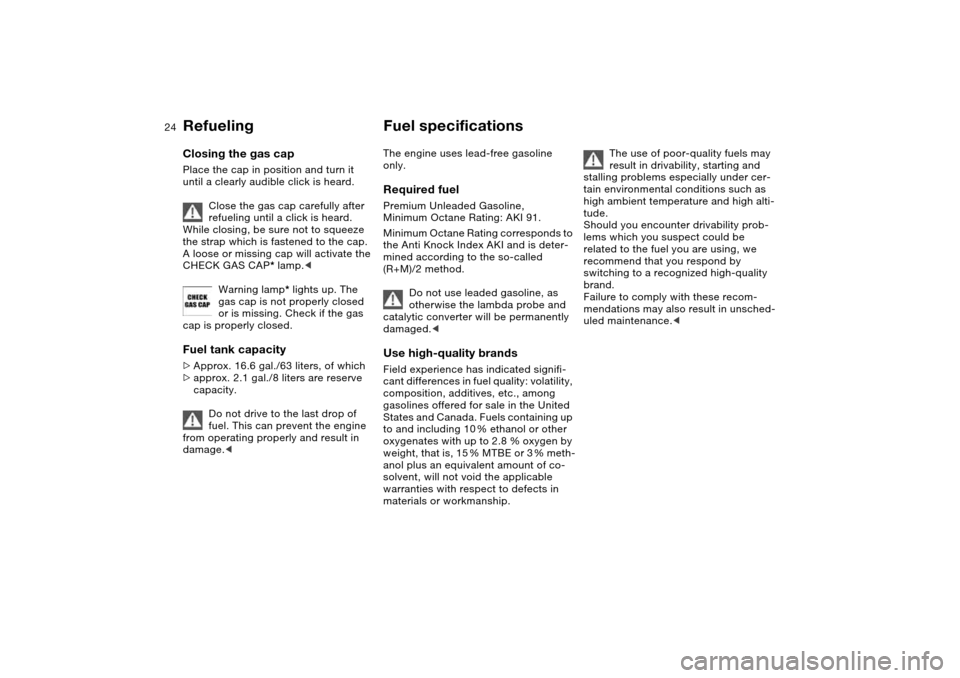
24
Closing the gas capPlace the cap in position and turn it
until a clearly audible click is heard.
Close the gas cap carefully after
refueling until a click is heard.
While closing, be sure not to squeeze
the strap which is fastened to the cap.
A loose or missing cap will activate the
CHECK GAS CAP* lamp.<
Warning lamp* lights up. The
gas cap is not properly closed
or is missing. Check if the gas
cap is properly closed.Fuel tank capacity >Approx. 16.6 gal./63 liters, of which
>approx. 2.1 gal./8 liters are reserve
capacity.
Do not drive to the last drop of
fuel. This can prevent the engine
from operating properly and result in
damage.<
Fuel specificationsThe engine uses lead-free gasoline
only.Required fuelPremium Unleaded Gasoline,
Minimum Octane Rating: AKI 91.
Minimum Octane Rating corresponds to
the Anti Knock Index AKI and is deter-
mined according to the so-called
(R+M)/2 method.
Do not use leaded gasoline, as
otherwise the lambda probe and
catalytic converter will be permanently
damaged.
cant differences in fuel quality: volatility,
composition, additives, etc., among
gasolines offered for sale in the United
States and Canada. Fuels containing up
to and including 10 % ethanol or other
oxygenates with up to 2.8 % oxygen by
weight, that is, 15 % MTBE or 3 % meth-
anol plus an equivalent amount of co-
solvent, will not void the applicable
warranties with respect to defects in
materials or workmanship.
The use of poor-quality fuels may
result in drivability, starting and
stalling problems especially under cer-
tain environmental conditions such as
high ambient temperature and high alti-
tude.
Should you encounter drivability prob-
lems which you suspect could be
related to the fuel you are using, we
recommend that you respond by
switching to a recognized high-quality
brand.
Failure to comply with these recom-
mendations may also result in unsched-
uled maintenance.<
Refueling
Page 74 of 174
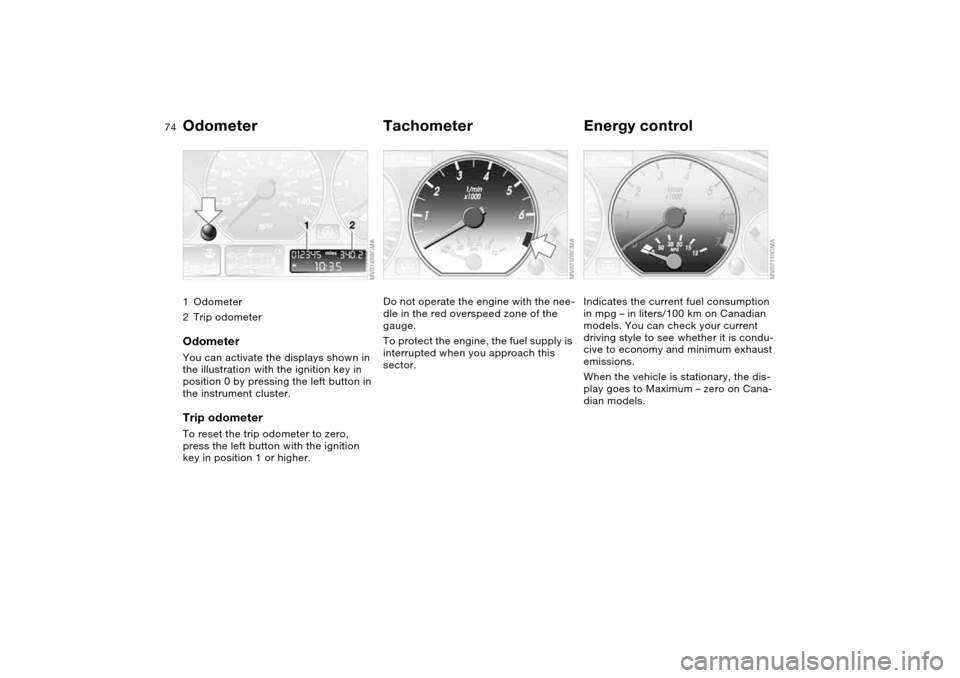
74Everything under control
Odometer1Odometer
2Trip odometerOdometerYou can activate the displays shown in
the illustration with the ignition key in
position 0 by pressing the left button in
the instrument cluster.Trip odometerTo reset the trip odometer to zero,
press the left button with the ignition
key in position 1 or higher.
TachometerDo not operate the engine with the nee-
dle in the red overspeed zone of the
gauge.
To protect the engine, the fuel supply is
interrupted when you approach this
sector.
Energy controlIndicates the current fuel consumption
in mpg – in liters/100 km on Canadian
models. You can check your current
driving style to see whether it is condu-
cive to economy and minimum exhaust
emissions.
When the vehicle is stationary, the dis-
play goes to Maximum – zero on Cana-
dian models.
Page 75 of 174
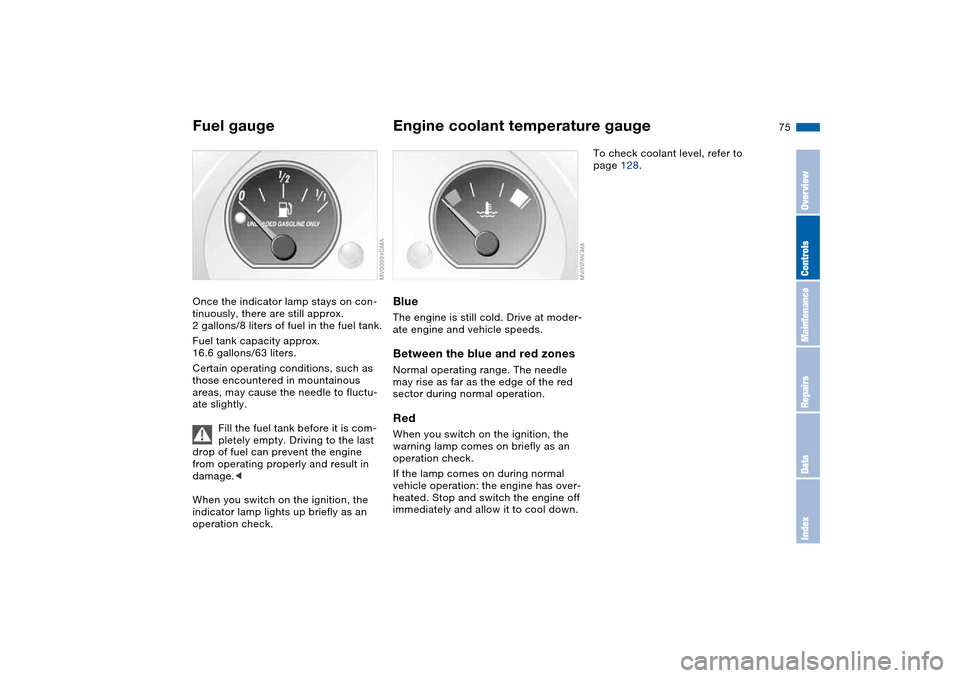
75
Fuel gaugeOnce the indicator lamp stays on con-
tinuously, there are still approx.
2 gallons/8 liters of fuel in the fuel tank.
Fuel tank capacity approx.
16.6 gallons/63 liters.
Certain operating conditions, such as
those encountered in mountainous
areas, may cause the needle to fluctu-
ate slightly.
Fill the fuel tank before it is com-
pletely empty. Driving to the last
drop of fuel can prevent the engine
from operating properly and result in
damage.<
When you switch on the ignition, the
indicator lamp lights up briefly as an
operation check.
Engine coolant temperature gaugeBlueThe engine is still cold. Drive at moder-
ate engine and vehicle speeds.Between the blue and red zonesNormal operating range. The needle
may rise as far as the edge of the red
sector during normal operation.RedWhen you switch on the ignition, the
warning lamp comes on briefly as an
operation check.
If the lamp comes on during normal
vehicle operation: the engine has over-
heated. Stop and switch the engine off
immediately and allow it to cool down.
To check coolant level, refer to
page 128.
OverviewControlsMaintenanceRepairsDataIndex
Page 76 of 174
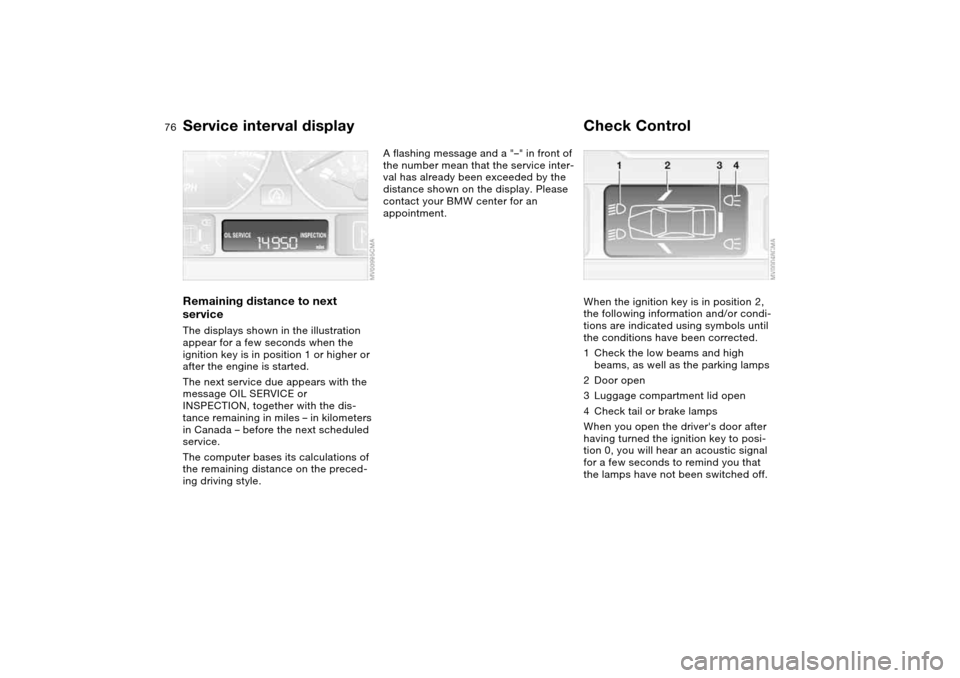
76
Service interval displayRemaining distance to next
serviceThe displays shown in the illustration
appear for a few seconds when the
ignition key is in position 1 or higher or
after the engine is started.
The next service due appears with the
message OIL SERVICE or
INSPECTION, together with the dis-
tance remaining in miles – in kilometers
in Canada – before the next scheduled
service.
The computer bases its calculations of
the remaining distance on the preced-
ing driving style.
A flashing message and a "–" in front of
the number mean that the service inter-
val has already been exceeded by the
distance shown on the display. Please
contact your BMW center for an
appointment.
Check ControlWhen the ignition key is in position 2,
the following information and/or condi-
tions are indicated using symbols until
the conditions have been corrected.
1Check the low beams and high
beams, as well as the parking lamps
2Door open
3Luggage compartment lid open
4Check tail or brake lamps
When you open the driver's door after
having turned the ignition key to posi-
tion 0, you will hear an acoustic signal
for a few seconds to remind you that
the lamps have not been switched off.
Page 126 of 174

126
Washer fluidsHeadlamp* and windshield
washer systemCapacity approx.
5.6 US quarts/5.3 liters
Fill with water and, if required, with a
washer antifreeze additive according to
manufacturer's recommendations.
We recommend that you mix the
washer fluid before adding it to
the reservoir.<
Antifreeze agents for the washer
fluid are highly flammable. For this
reason, keep them away from sources
of flame and store them only in closed
original containers, inaccessible to chil-
dren. Comply with the instructions on
the containers.<
Engine oilChecking the oil level1. Park the vehicle on a level surface
2. Switch the engine off after it has
reached normal operating tempera-
ture
3. After approx. 5 minutes, pull the dip-
stick out and wipe it off with a clean
lint-free cloth, paper towel, or similar
material
4. Carefully push the dipstick all the
way into the guide tube and pull it
out again
5. The oil level should be between the
two marks on the dipstick.
As with fuel economy, oil consumption
is directly influenced by your driving
style and vehicle operating conditions.
The oil volume between the two marks
on the dipstick corresponds to approx.
1.1 US quarts/1 liter. Do not fill beyond
the upper mark on the dipstick. Excess
oil will damage the engine.